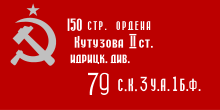|
79th Rifle Corps
The 79th Rifle Corps (Russian: 79-й стрелковый корпус) was a rifle corps of the Red Army in World War II that became part of the Soviet Army during the Cold War. World War IIThe corps was formed in July 1943 as a headquarters with no troops assigned, and subordinated to the Ural Military District.[1] The headquarters was subsequently transferred to the 21st Army of the Western Front in August,[2] and the 20th Army of the Reserve of the Supreme High Command in September.[3] The 79th joined the 3rd Shock Army of the 2nd Baltic Front in October, with which it remained for the rest of the war, and was assigned the 146th and 326th Rifle Divisions[4] under the command of Major General Fyodor Zuyev from 15 October.[5] The 146th and 326th were replaced by the 28th, 171st, and 219th Rifle Divisions in November.[6]  On May 1, 1945, the 79th Rifle Corps was the superior headquarters for the 150th, 171st, and 207th Rifle Divisions. The 150th Rifle Division was among those units that stormed the Reichstag. In recognition of its actions, the corps received the Berlin honorific shortly after the end of the war.[7] PostwarPostwar, it remained part of the 3rd Shock Army (redesignated as the 3rd Army in 1954) in the Group of Soviet Occupation Forces in Germany (renamed the Group of Soviet Forces in Germany in 1954), stationed at Stendal. The 171st Rifle Division was converted into the 16th Mechanized Division by the end of 1945, but was withdrawn to the Moscow Military District and disbanded there in 1946. The 150th Rifle Division was disbanded in Germany later that year, and was replaced by the 19th Guards Mechanized Division, transferred from the 8th Guards Army; the corps consisted of the 207th and the 19th Guards for the rest of its existence. In accordance with a General Staff directive of 4 March 1955 and a Ministry of Defense order of 13 June, the corps was renumbered as the 23rd Rifle Corps. The headquarters of the latter was disbanded on 4 July 1956, with its divisions directly subordinated to the army headquarters.[7][8] CommandersThe following officers commanded the corps during its existence:[9]
ReferencesCitations
Bibliography
|
||||||||||||||||
Portal di Ensiklopedia Dunia